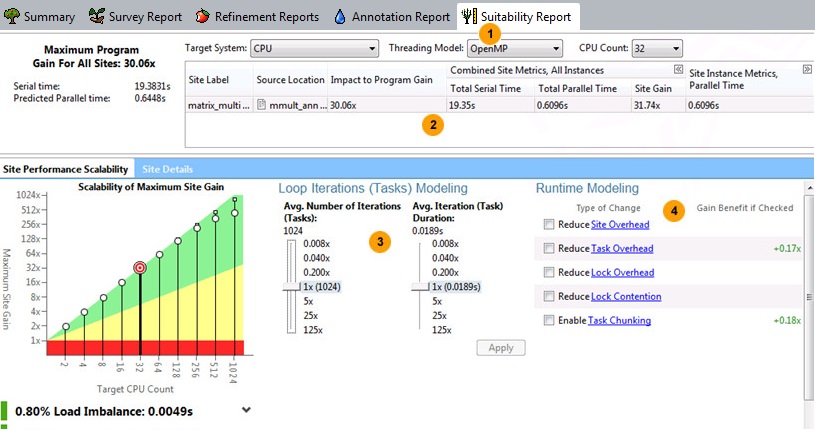Visible to Intel only — GUID: GUID-02A8E545-9374-454B-AB40-521A5716379D
Visible to Intel only — GUID: GUID-02A8E545-9374-454B-AB40-521A5716379D
Choose Modeling Parameters in the Suitability Report
The Suitability Report lets you adust modeling parameters based on possible application needs. When using an active result, you can adjust modeling parameters and quickly view the likely impact on the predicted performance interactively.

This screen shows data based on a Target System of CPU. The screen shown on your system may differ. If you use other Target System values for the Intel® Xeon Phi™ processor, additional modeling values appear. See Suitability Report Overview.
|
The top row of modeling parameters provides drop-down lists that let you define the likely hardware configuration of target systems as well as the high-level parallel framework. These values let you predict the likely performance characteristics for the selected parallel site.
As you modify these modeling parameters, the predicted performance estimates are updated automatically. Repeat as needed. |
|
If your target app contains multiple parallel sites, select each parallel site you wish to examine. When you select a different parallel site, the predicted performance estimates for that site are updated automatically. Repeat as needed for each site. |
|
Use the Loop Iterations (Tasks) Modeling or Tasks Modeling area to view the impact of changing the number of iterations and the iteration duration on the predicted performance for the selected parallel site (the label displayed depends on whether iteration loop annotations or general task annotations were detected). For example, you might want to see the impact of modifying your nested change loop structure, modify the loop body code, or change number of iterations. After you slide the Avg. Number of Iterations (Tasks): or Avg. Number of Tasks: and the Avg. Duration values, click the Apply button to view the predicted performance estimates. Repeat as needed. |
|
Use the Runtime Modeling area to view the predicted impact of adjusting run-time parallel characteristics after you add parallelism for the selected parallel site, including using parallel framework capabilities to minimize parallel overhead or tuning your parallel code. If you agree to later check and modify runtime performance aspects for a category, check the box to the left of that category name. For example, you can also examine and tune actual parallel code performance characteristics using tools like Intel® VTune™ Profiler and implement the runtime capabilities of high-level parallel frameworks to limit parallel overhead, such as task chunking. As you check or uncheck different categories, the predicted performance estimates are updated automatically. Repeat as needed. If you choose Target System as Intel Xeon Phi or Offload to Intel Xeon Phi, additional Intel Xeon Phi Advanced Modeling options (not shown) appear below Runtime Modeling (see Advanced Modeling). |
The Intel® Advisor Suitability tool predicts the general performance characteristics of CPUs. For example, it does not consider CPU clock frequency, cache characteristics, versions of processors, and so on.



